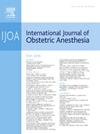硬膜外穿刺处动脉出血1例
IF 2.3
3区 医学
Q2 ANESTHESIOLOGY
引用次数: 0
摘要
这个病例强调了一个罕见的并发症,浅动脉出血从硬膜外穿刺部位。一位27岁的初产妇在妊娠38周时因产科胆汁淤积而入院引产。在L4-L5脊柱水平用16G Tuohy针插入硬膜外分娩镇痛。吸入时发现有血渍液体,于是将其取出。随后,出现硬膜外动脉出血,尽管用肾上腺素和氨甲环酸浸泡的棉签长时间按压,但仍持续出血。最终使用荷包缝合和出血部位两侧皮下肾上腺素20 μg控制出血,估计总失血量为500 mL。干预后无神经系统问题,无心血管改变或浅表血肿形成的证据。硬膜外相关动脉出血是非常罕见的,主要关注的是硬膜外血肿的风险,特别是如果出血来源不明。在文献中,只有4例病例报告详细描述了硬膜外手术后浅表动脉出血的不同处理策略,包括荷包缝合或不同剂量的皮下肾上腺素(30 μg - 300 μg)。这两种技术都有潜在的风险。在这个病例中,荷包缝合和低剂量皮下肾上腺素的结合有效地控制了出血,没有并发症。我们建议使用最低有效剂量的皮下肾上腺素与警惕的产妇和胎儿监测。任何下肢神经系统的改变都需要紧急成像和神经外科评估,以排除硬膜外血肿。本文章由计算机程序翻译,如有差异,请以英文原文为准。
Arterial bleed from an epidural puncture site: a case report
This case highlights a rare complication of superficial arterial bleeding from an epidural puncture site.
A 27-year-old primigravida was admitted for induction of labour at 38 weeks' gestation due to obstetric cholestasis. An epidural for labour analgesia was inserted at spinal level L4-L5 with a 16G Tuohy needle. Blood-stained fluid was noted on aspiration, prompting its removal. Subsequently, there appeared to be arterial bleeding from the epidural site, which persisted despite prolonged pressure with epinephrine and tranexamic acid soaked swabs. The bleeding was ultimately controlled using a purse-string suture and subcutaneous epinephrine 20 μg on each side of the bleeding site, with a total estimated blood loss of 500 mL. There were no neurological concerns and no cardiovascular changes or evidence of formation of a superficial haematoma following the interventions.
Epidural related arterial bleeding is exceptionally rare and the primary concern is the risk of an epidural haematoma, especially if the source of the bleeding is unknown. There are only four case reports in the literature detailing superficial arterial bleeding following an epidural with differing management strategies including a purse-string suture or varying doses of subcutaneous epinephrine (30 μg−300 μg). Both techniques carry potential risks. In this case, a combination of a purse-string suture and low-dose subcutaneous epinephrine effectively controlled the bleeding, with no complications. We recommend using the lowest effective dose of subcutaneous epinephrine with vigilant maternal and fetal monitoring. Any lower limb neurological changes warrants urgent imaging and a neurosurgical evaluation to exclude an epidural haematoma.
求助全文
通过发布文献求助,成功后即可免费获取论文全文。
去求助
来源期刊
CiteScore
4.70
自引率
7.10%
发文量
285
审稿时长
58 days
期刊介绍:
The International Journal of Obstetric Anesthesia is the only journal publishing original articles devoted exclusively to obstetric anesthesia and bringing together all three of its principal components; anesthesia care for operative delivery and the perioperative period, pain relief in labour and care of the critically ill obstetric patient.
• Original research (both clinical and laboratory), short reports and case reports will be considered.
• The journal also publishes invited review articles and debates on topical and controversial subjects in the area of obstetric anesthesia.
• Articles on related topics such as perinatal physiology and pharmacology and all subjects of importance to obstetric anaesthetists/anesthesiologists are also welcome.
The journal is peer-reviewed by international experts. Scholarship is stressed to include the focus on discovery, application of knowledge across fields, and informing the medical community. Through the peer-review process, we hope to attest to the quality of scholarships and guide the Journal to extend and transform knowledge in this important and expanding area.

 求助内容:
求助内容: 应助结果提醒方式:
应助结果提醒方式:


